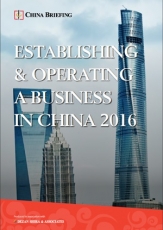China Market Watch: Civil Air Market Open to Private Investment and Railway Investment Targets Met
First three quarters see steel exports rise by 2.4%, coal and steel capacity reduction targets met
China’s steel exports stood at 85 million metric tons in the first nine months of 2016, up 2.4 percent from the same period last year. This increase has been accredited to Asian countries whose construction demand is high, and will continue to rise due to belt and road projects, with property, transport, environmental management and irrigation infrastructure generating the most demand. For the last quarter of 2016, real estate, construction and machinery manufacture will consume the most steel. The increase in anti-dumping tariffs and other trade frictions have made many steel producing companies focus on direct sales overseas, cutting out trade companies in order to understand firsthand the requirements of buyers.
Meanwhile, domestically, China is expected to hit its annual steel output target by the end of this month, following efforts to reduce capacity of heavy commodities. Similar targets for coal are expected to be met by the end of November, according to the National Development and Reform Commission. Over 80 percent of the targeted reductions were met by the steel and coal sectors by the end of this September, with some larger state-owned enterprises already hitting the annual targets, due to strengthened supervision and inspection.
China fully opens civilian airport market to private capital
The Civil Aviation Administration of China (CAAC) has opened up the country’s civilian airport market to private investment. A guideline granting access allows private investment into all airport projects in the outline for airport development or special regional and industrial planning. Investment and public private partnerships have been encouraged in an effort to improve service quality and efficiency, and no longer require agency approval to fund terminals, logistical facilities and warehousing, ground services, etc. Boeing has estimated that in 20 years, China’s aviation market will become the world’s first to exceed a value of USD 1 trillion, requiring over 6800 new aircrafts to fulfill demand. Currently, numbers of domestic airports are insufficient for the increasing volume of passengers. Opening the market to foreign investment is hoped to alleviate financial pressure in the country’s efforts to accelerate construction projects.
China set to meet annual railway investment target
China is set to hit its annual railway investment target, with its fixed-asset investment in the sector reaching RMB 542.3 billion in the first three quarters of 2016, up 10.3 percent from the previous year. This figure was boosted by an increase in state investment, which rose by 12 percent to RMB 517 billion. Railway construction has seen growth since the beginning of the year, and is sure to exceed the fixed asset investment target of RMB 800 billion. There are 45 railway projects set for 2016, adding a further 3,200 kilometer of rail, 1,300 of which will be for high speed railways. China has an extensive and efficient rail system, but has recently looked to its underdeveloped western regions which are behind in construction terms; two further railway projects with a total investment of RMB 79.47 billion have been approved. Plans to spend RMB 3.5 trillion have been drafted to lay over 30,000 km of track in central and western regions within the next five years.
|
Asia Briefing Ltd. is a subsidiary of Dezan Shira & Associates. Dezan Shira is a specialist foreign direct investment practice, providing corporate establishment, business advisory, tax advisory and compliance, accounting, payroll, due diligence and financial review services to multinationals investing in China, Hong Kong, India, Vietnam, Singapore and the rest of ASEAN. For further information, please email china@dezshira.com or visit www.dezshira.com. Stay up to date with the latest business and investment trends in Asia by subscribing to our complimentary update service featuring news, commentary and regulatory insight.
|

 Establishing & Operating a Business in China 2016
Establishing & Operating a Business in China 2016
Establishing & Operating a Business in China 2016, produced in collaboration with the experts at Dezan Shira & Associates, explores the establishment procedures and related considerations of the Representative Office (RO), and two types of Limited Liability Companies: the Wholly Foreign-owned Enterprise (WFOE) and the Sino-foreign Joint Venture (JV). The guide also includes issues specific to Hong Kong and Singapore holding companies, and details how foreign investors can close a foreign-invested enterprise smoothly in China.
 An Introduction to Doing Business in China 2016
An Introduction to Doing Business in China 2016
Doing Business in China 2016 is designed to introduce the fundamentals of investing in China. Compiled by the professionals at Dezan Shira & Associates in June 2016, this comprehensive guide is ideal not only for businesses looking to enter the Chinese market, but also for companies who already have a presence here and want to keep up-to-date with the most recent and relevant policy changesSelling, Sourcing and E-commerce in China 2016
 Selling, Sourcing and E-Commerce in China 2016 (First Edition)
Selling, Sourcing and E-Commerce in China 2016 (First Edition)
This guide, produced in collaboration with the experts at Dezan Shira & Associates, provides a comprehensive analysis of all these aspects of commerce in China. It discusses how foreign companies can best go about sourcing products from China; how foreign retailers can set up operations on the ground to sell directly to the country’s massive consumer class; and finally details how foreign enterprises can access China’s lucrative yet ostensibly complex e-commerce market.
- Previous Article China & Russia Propose Vast Eurasian Free Trade Zone & SCO Development Bank
- Next Article Puntos clave de la industria de la alimentación y la bebida en China










